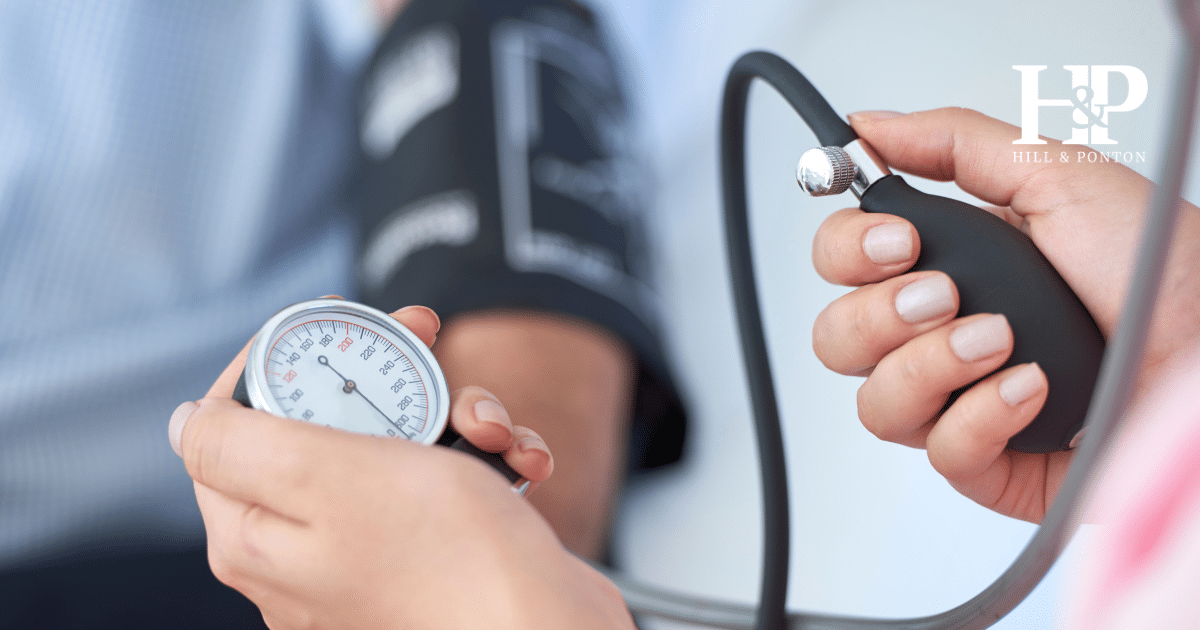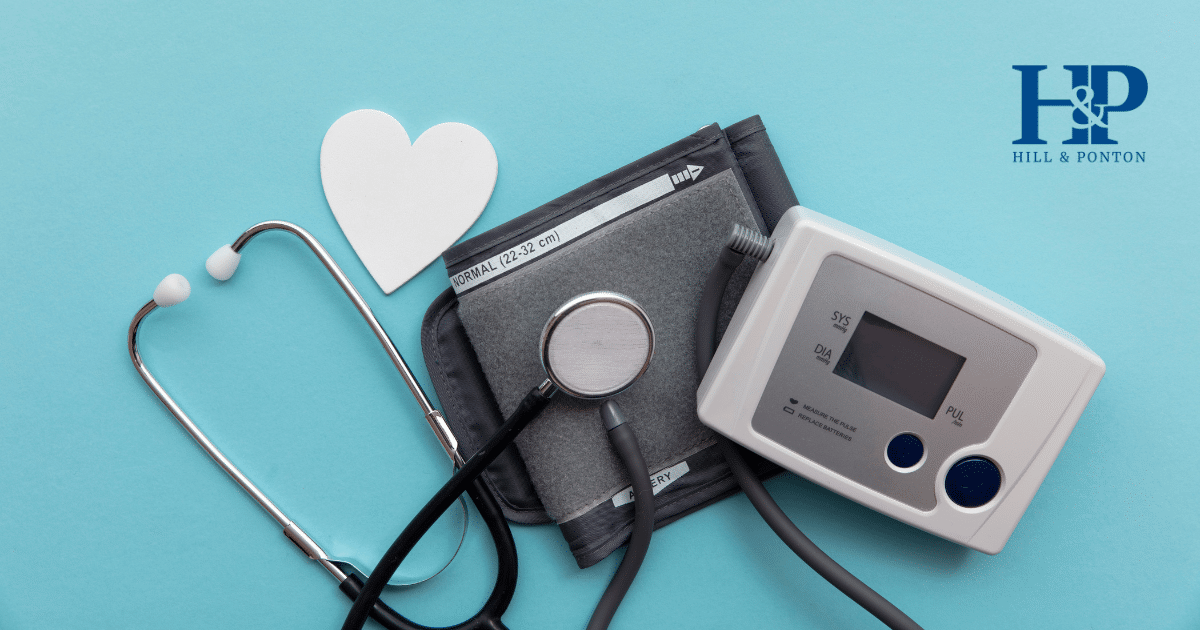The number of hypertension claims has surged, particularly among veterans of the Vietnam War and post-9/11 conflicts. This increase is due to both medical advances (better screening) and broader recognition of the interconnected nature of chronic conditions faced by veterans, especially those related to toxic exposures and mental health.
Many veterans don’t just have hypertension: they also deal with diabetes, PTSD, sleep apnea, kidney disease, or a combination of these conditions. The compounding effect of these diagnoses often leads to more severe symptoms and greater difficulty managing blood pressure, which could make veterans eligible for higher VA disability ratings, Individual Unemployability, and Special Monthly Compensation.
Hill & Ponton’s updated guide informs veterans about the VA rating criteria for hypertension and how to establish service connection, file and win a VA claim, and increase disability compensation.
What is the VA Rating for Hypertension?
The VA rates hypertension at 0%, 10%, 20%, 40% and 60%, depending on blood pressure readings and the need for continuous medication.
- 0%: This percentage is granted when the veteran has a diagnosis of hypertension related to their military service but they do not meet the criteria for a compensable rating.
- 10% Rating: Diastolic pressure predominantly 100 or more, or; systolic pressure predominantly 160 or more, or; minimum evaluation for an individual with a history of diastolic pressure predominantly 100 or more who requires continuous medication for control.
- 20% Rating: Diastolic pressure predominantly 110 or more or systolic pressure predominantly 200 or more.
- 40% Rating: Diastolic pressure predominantly 120 or more.
- 60% Rating: Diastolic pressure predominantly 130 or more.
VA Rating for Hypertension While on Medication
If a veteran requires continuous medication to control their high blood pressure, hypertension is given a 0% rating. While a 0% rating for hypertension does not qualify the veteran for monthly compensation, it establishes service connection, which allows the veteran to seek higher compensation if the condition gets worse, or claim secondary conditions such as sleep apnea.
The VA will also assist the veteran in getting medications, provide treatment, and offer Dependency and Indemnity benefits to eligible surviving dependents if the veteran passes away due to a condition related to their hypertension such as a heart attack or stroke.
Maximize Your Benefits
Unhappy with your VA decision? We’re here to help. Contact us for a free review of your case.
Is Hypertension a Presumptive Condition?
Certain conditions are considered “presumptive” by VA, meaning they are presumed to be service-connected without the need for specific evidence linking the condition to military service. Hypertension is a presumptive condition for veterans exposed to Agent Orange and other herbicides during their service. It is also presumptive if it manifests to a minimum rating of 10% within one year of discharge, under VA rating regulations for chronic diseases.
How Presumptive Service Connection Works for Hypertension
If you served in a qualifying location and are later diagnosed with hypertension, the VA will automatically presume that your condition is linked to the military service. You do not need to prove direct causation, as long as you have a diagnosis of hypertension and documented presence in areas with recognized exposure to:
- Agent Orange (Vietnam, Thailand, Korean DMZ, Laos, Cambodia, Guam)
- Burn pits (Iraq, Afghanistan, and other post-9/11 Middle Eastern deployments)
- Other airborne hazards and toxic substances covered under the PACT Act
How To Prove Service Connection
If hypertension is not covered under the presumptive conditions, veterans can establish an entitlement to VA disability through direct or secondary service connection, or through aggravation.
Direct Service Connection
Direct service connection applies when hypertension was first diagnosed during active duty or manifested to a compensable degree within one year after separation (per 38 CFR § 3.307, § 3.309). To establish direct service connection, veterans require:
- Medical Evidence – Detailed medical records showing a diagnosis of hypertension during or shortly after military service
- Nexus Letter – A letter from a qualified medical professional linking hypertension to military service
- Service Medical Records – Documentation of high blood pressure readings (≥140/90 mmHg) or related health issues during service
While in-service hypertension diagnoses are common, some veterans may not have received a formal diagnosis despite multiple elevated readings. In such cases, continuity of symptomatology, supported by post-service treatment records and a VA or private physician’s opinion, may help establish service connection.
Service Connection By Aggravation (for Pre-existing Hypertension)
This applies when hypertension existed before service, but military service worsened it beyond natural progression. To be service connected under 38 CFR § 3.306 – Aggravation of pre-existing conditions, veterans must provide:
- Medical records pre-dating service showing prior hypertension
- In-service records showing increased severity (more frequent or severe elevations, new treatment)
- Medical opinions confirming aggravation beyond normal progression
Secondary Service Connection
Hypertension is often granted as secondary to another service-connected disability. In this situation, the veteran’s high blood pressure must be shown to be caused or aggravated by an existing service-connected condition.
Disabilities That Can Contribute to Hypertension
- PTSD – Chronic stress raises cortisol and adrenaline levels, both of which elevate blood pressure.
- Diabetes Mellitus (Type II) – Diabetic vascular and renal damage increases hypertension risk.
- Chronic Kidney Disease – Impaired renal function disrupts blood pressure regulation (and vice versa).
- Sleep Apnea – Repeated oxygen deprivation at night leads to sustained hypertension.
- Chronic Pain – Triggers sympathetic nervous system activation, increasing blood pressure.
- Obesity – While not rated as a disability by the VA, it is often recognized as being linked to other service-connected orthopedic or psychological conditions, which means it can be used as an intermediary step to connect them to hypertension (i.e. the primary disability involves overeating or immobility causing weight gain, which in turn causes cardiovascular strain).
Recent research shows that the incidence of hypertension is rising among younger service members, consistent with higher trends of risk factors including obesity and type 2 diabetes.
How Hill & Ponton Helped a Veteran Service Connect Hypertension Secondary to Diabetes
In this 2016 appeal, attorney Carol Ponton successfully secured service connection for hypertension on a secondary basis to diabetes mellitus, despite an unfavorable Compensation & Pension examination and an earlier denial by the VA.
The veteran initially filed a claim for hypertension secondary to diabetes mellitus in March 2008. Although his service treatment records contained no mention of hypertension, he provided decades of private medical records documenting both conditions and their progression. However, in December 2008 a VA examiner issued an unfavorable opinion, claiming that hypertension and diabetes were diagnosed “concurrently” and suggesting no causal link.
To counter this, Hill & Ponton submitted several private medical opinions. In a September 2009 letter, the veteran’s private physician confirmed that he was first diagnosed with diabetes mellitus in March 1997. Shortly after that diagnosis, the veteran began exhibiting early signs of hypertension, which the physician identified as a secondary condition resulting from his diabetes. In an October 2009 statement, the veteran’s private cardiologist likewise concluded that the veteran’s hypertension was a direct consequence of his diabetes.
In June 2010, letters from both the cardiologist and the treating physician emphasized that hypertension developed after diabetes and was “at least as likely as not” caused by it. In addition, the veteran experienced hospitalization in 2015 for hypertensive urgency. Physicians noted the role of autonomic neuropathy (a known complication of diabetes) as contributing to uncontrolled blood pressure episodes.
After reviewing all the evidence, the Board of Veterans’ Appeals found the 2008 VA opinion inadequate and concluded that the private medical opinions provided sufficient support to apply the benefit of the doubt in the veteran’s favor. As a result, the Board granted service connection for hypertension as secondary to diabetes.
Citation Nr: 1606079 | Decision Date: 02/17/16
Hill & Ponton lawyers have a 96% success rate for appeals handled nationwide. Find out more about the other veterans we’ve helped.
Making a VA Claim for Hypertension
- Log in to your VA.gov account
- Fill out VA Form 21-526EZ, “Application for Disability Compensation and Related Compensation Benefits”
- Provide detailed information about your hypertension, including when it was first diagnosed and its connection to your service
Supporting Documents to Upload:
- Medical records and treatment documentation
- Service medical records showing high blood pressure
- Nexus letter from your doctor
- Additional supporting documents, like statements from family or coworkers
Review your information for accuracy and submit the claim. Keep track of your VA claim status through your VA.gov account, and be prepared to provide additional information or attend a VA Compensation & Pension exam if requested.
To learn more about filing (and winning) a VA claim, check out the Hill & Ponton FREE step by step guide.
VA Denied My Hypertension Claim!
If your hypertension claim is denied, there are steps you can take to turn things around:
- Understand the Reason for Denial: Carefully review VA’s decision letter to understand why the hypertension claim was denied.
- Gather Additional Evidence: Collect any new or missing medical records, statements, or expert opinions that support your hypertension claim.
- File an Appeal: Submit a Notice of Disagreement and consider seeking legal assistance to increase your chances of winning. Contact us today to see if we are able to help.
How to Increase a Hypertension Disability Rating
- Document Worsening Symptoms: Keep detailed records of your blood pressure readings, any new symptoms, and how your condition has worsened.
- Medical Re-Evaluation: Obtain updated medical evaluations that reflect the current severity of your hypertension.
- File a Claim for Increased Rating : Submit a claim with VA, providing the new medical evidence and documentation of your worsening condition or evidence of an error in the initial rating.
- File for Secondary Conditions: Hypertension can lead to other health issues, which may qualify for additional compensation. See what conditions are secondary to hypertension.
Case Example: How a Veteran Won a Compensable Rating
A veteran who served on active duty from 1977 to 1981 and from 1982 to 1998 filed a claim for service connection for hypertension. Initially, the veteran was granted service connection but assigned a noncompensable (0 percent) rating. He appealed this decision, arguing that he should receive a compensable rating for hypertension because, even with continuous medication, his diastolic readings would average 100 or more.
The veteran testified that his diastolic pressure was 100 or higher when he was first prescribed medication. He provided evidence from his VA treatment records, including a notable reading of 164/105 during an emergency room visit. Although the veteran did not provide private medical records or a detailed diary of his blood pressure, his testimony, combined with the available medical records, was sufficient to meet the criteria for a 10% rating.
The Board granted an increased rating of 10% for the veteran’s service-connected hypertension. The contributing factors to his success included:
- Consistent Medical Evidence: VA treatment records showed elevated blood pressure readings, and the veteran testified about his history of high blood pressure.
- Testimony on Medication Use: The veteran explained that he needed continuous medication to control his blood pressure, which supported the requirement for a compensable rating.
- Key Medical Record: The emergency room reading of 164/105 provided strong evidence that the veteran’s blood pressure could reach compensable levels without medication.
The Board found that the veteran’s hypertension met the criteria for a 10% rating due to the history of diastolic pressure reaching 100 or more, even though his blood pressure was controlled by medication.
TDIU: 100% Compensation for Hypertension
Total Disability Individual Unemployability (TDIU) is an option if high blood pressure severely impacts your ability to work. TDIU provides benefits at the 100% disability rate even if your combined percentage is less than 100%.
If your condition is rated at 60% alone or you have another condition at 40% and combined with your hypertension and any other service connected conditions equals a 70% rating (the hypertension does not need to be 40%, just one of the combined conditions does) and prevents you from maintaining substantially gainful employment, you could qualify for TDIU.
Frequently Asked Questions (FAQ)
If you don’t qualify under presumptive rules and didn’t have documented high blood pressure in service or within one year after, you’ll need to provide strong medical evidence to establish a connection. Many veterans are denied because they don’t have the right evidence or legal strategy.
Yes. Even if your blood pressure is well-managed with medication, the VA recognizes that requiring continuous medication can still qualify you for a 0% rating, and may support service connection. If your historical readings meet compensable thresholds, you may qualify for a 10% rating or higher.
The average VA rating for hypertension tends to be around 0-10%, reflecting the common need for continuous medication and moderate elevation in blood pressure readings. Ratings of 20%, 40%, or 60% are less common, and require consistent documentation of diastolic pressures above 110, 120, or 130, respectively.
Home readings may be helpful but the VA prefers readings from licensed medical professionals or during VA exams. Still, you should keep a log of readings (especially if you spike without medication) and submit it as supporting evidence.
Yes. If hypertension leads to or aggravates secondary conditions like heart disease, stroke, or chronic kidney disease, each may qualify for separate ratings. These ratings are then combined under VA math, potentially increasing the total disability rating.
Hypertension by itself isn’t enough for TDIU, unless it causes severe complications like stroke, heart failure, or renal failure. However, if hypertension contributes to multiple conditions that impact your ability to work, you may qualify for TDIU.
Hypertension alone does not qualify for Special Monthly Compensation. But when it causes or aggravates serious secondary conditions (such as stroke, heart disease, or end-stage kidney failure), it may help a veteran meet the criteria for SMC-L, SMC-S, or even higher levels depending on the severity and care required.
Did the VA Deny Your Disability Claim?
Let our team review your case today!
Get a Free Case Evaluation



